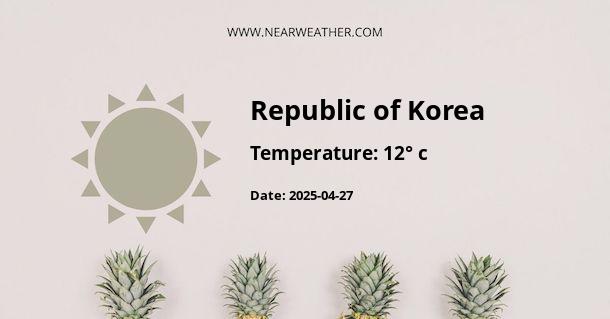The Climate and Weather in the Republic of Korea
The Republic of Korea, commonly known as South Korea, is located in Eastern Asia and has a diverse climate due to its varied terrain and geographical location. The climate in South Korea is generally characterized by four distinct seasons: spring, summer, autumn, and winter. Each season brings its own unique weather patterns and temperature variations, making South Korea an interesting destination for travelers throughout the year.
Spring (March to May)
Spring in South Korea is a beautiful season, marked by cherry blossoms and mild temperatures. The weather gradually warms up after the cold winter months, and the landscape comes alive with vibrant colors. The average temperature during spring ranges from 10°C (50°F) to 20°C (68°F), making it a pleasant time to explore the country.
Rainfall is common during the spring months, with April being the wettest month. However, the showers are usually short-lived, and the sun quickly emerges. It is advisable to carry an umbrella or raincoat when exploring outdoor attractions.
Spring is also the time for various festivals and events, including the famous Cherry Blossom Festivals that take place in cities like Seoul, Busan, and Jeju Island. The blooming cherry blossoms create a picturesque scenery that attracts both locals and tourists alike.
Summer (June to August)
Summer in South Korea is hot and humid, with temperatures ranging from 25°C (77°F) to 35°C (95°F). It is the peak tourist season due to the school holidays and favorable weather conditions. The country experiences an increase in rainfall during this time, with July and August being the wettest months.
Despite the high temperatures and humidity, summer is a popular time to visit South Korea due to the various outdoor activities and events that take place. Beaches along the coasts, such as Haeundae Beach in Busan and Gyeongpo Beach in Gangneung, attract locals and tourists looking to cool off and enjoy water sports.
It is important to stay hydrated and wear light clothing during the summer months. It is also advisable to apply sunscreen and carry an umbrella to protect against both rain and sun.
Autumn (September to November)
Autumn in South Korea is considered the most favorable season for many tourists. The weather is mild and comfortable, with temperatures ranging from 10°C (50°F) to 20°C (68°F). The humidity decreases, and the foliage transforms into a stunning display of vibrant colors.
Autumn is a popular time for outdoor activities such as hiking and visiting national parks. The picturesque landscapes, especially in areas like Nami Island and Seoraksan National Park, attract photographers and nature enthusiasts from around the world.
September and October are relatively dry months, with November starting to see an increase in rainfall. It is advisable to pack a light jacket or sweater for cooler evenings during this season.
Winter (December to February)
Winter in South Korea is cold, with temperatures dropping below freezing in many parts of the country. The average temperature during winter ranges from -5°C (23°F) to 5°C (41°F). The northern regions, such as Seoul and Gangwon Province, experience heavier snowfall compared to the southern regions.
Winter sports enthusiasts flock to ski resorts such as Yongpyong Resort and Alpensia Resort, which hosted the 2018 Winter Olympics. These resorts offer various winter activities, including skiing, snowboarding, and ice skating.
December is generally drier, while January and February see increased snowfall. It is essential to dress warmly with layers, including a heavy coat, hat, gloves, and boots, to stay comfortable during the chilly winters.
Overall Climate Summary
The Republic of Korea experiences a diverse climate with four distinct seasons. Spring and autumn are considered the most pleasant times to visit, with mild temperatures and beautiful landscapes. Summer is hot and humid but attracts tourists due to various outdoor activities and events. Winter is cold and snowy, offering opportunities for winter sports.
Here is a summary of the average temperatures and precipitation for each season:
| Season | Average Temperature | Precipitation |
|---|---|---|
| Spring | 10°C (50°F) to 20°C (68°F) | Varies, with April being the wettest month |
| Summer | 25°C (77°F) to 35°C (95°F) | Increased rainfall, with July and August being the wettest months |
| Autumn | 10°C (50°F) to 20°C (68°F) | Relatively dry, with an increase in rainfall in November |
| Winter | -5°C (23°F) to 5°C (41°F) | December is drier, while January and February see increased snowfall |
It is important to note that these are average temperatures and precipitation levels, and variations can occur depending on the specific location within South Korea.
"South Korea offers a unique climate experience throughout the year, from cherry blossoms in spring to snowy mountains in winter. It is a destination that caters to various outdoor activities and cultural festivals, making it a year-round tourist attraction." - Weather Expert
Whether you prefer the vibrant colors of spring, the sunny beaches of summer, the stunning landscapes of autumn, or the winter wonderland of snow-covered mountains, the Republic of Korea has something to offer throughout the year.
A - Republic of Korea's Latitude is 37.000000 & Longitude is 127.500000.
A - Weather in Republic of Korea is 12° today.
A - Climate Conditions in Republic of Korea shows overcast clouds today.
A - Humidity in Republic of Korea is 49% today.
A - Wind speed in Republic of Korea is 7.09 km/h, flowing at 191° wind direction. today.
